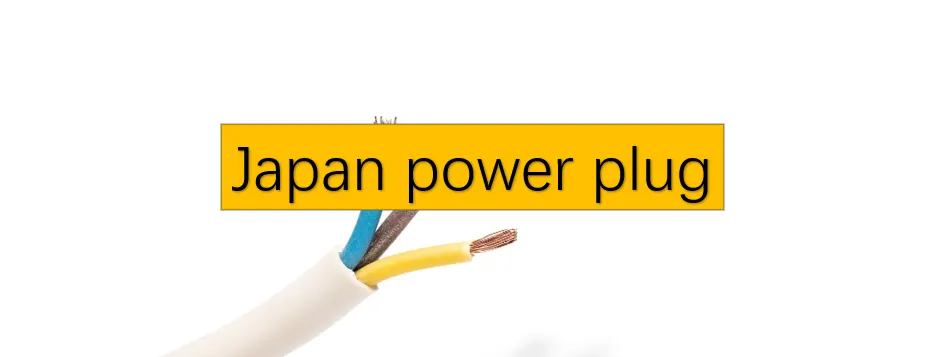
Heading to Japan? Don't forget to bring your Japan power plug adapter! Unlike Australia, which uses Type I power plugs, Japan primarily uses Type A and Type B plugs, with a standard voltage of 100V. So, to avoid the frustration of dead devices when you need them most, a travel adapter is a must-have.
Whether you're dealing with a Type A two-prong flat plug or a Type B with an additional grounding pin, you'll need the right Japan power plug adapter to fit Japanese outlets. Keep in mind that Japan operates on a 100V system, which is lower than Australia’s 230V, so some of your devices may require a voltage converter.
From plug types to voltage specifics, this guide covers everything you need to ensure your devices stay charged and you remain powered up during your adventure in Japan!
The Different Types of Power Plugs in Japan
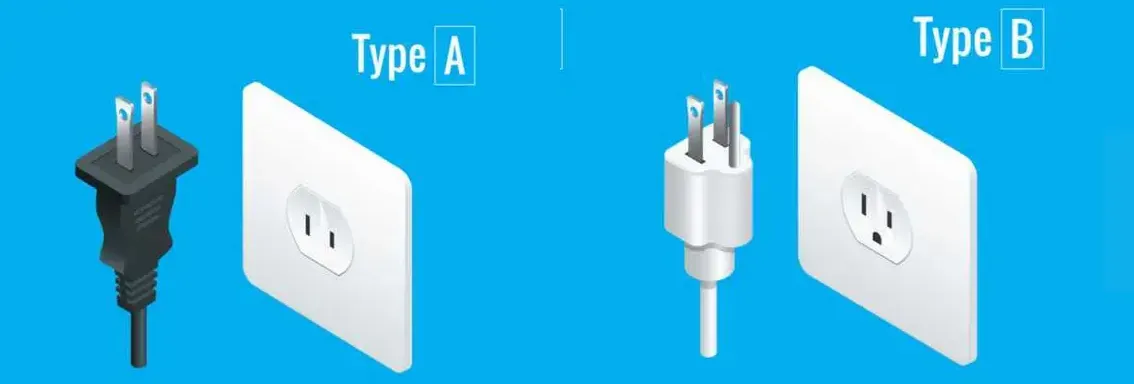
Heading to Japan? Don’t forget to pack your power plug adapter! While Australia uses the Type I plug with its grounding pin, Japan mainly uses Type A and Type B plugs. Understanding these plug types will ensure you can easily charge your devices and stay powered up as you explore Japan’s fascinating culture and cities.
Types of Power Plugs in Japan: Type A and Type B
Let’s break down the two main types of plugs you’ll encounter in Japan. This guide will help you make sure you’re always prepared when it’s time to plug in your devices.
| Feature | Type A | Type B |
| Shape of Pins | Two flat parallel prongs | Two flat prongs plus a round grounding prong |
| Pin Size | Small and flat | Larger and flat with a round grounding pin |
| Voltage | 100V | 100V |
| Frequency | 50 Hz or 60 Hz | 50 Hz or 60 Hz |
| Grounding Pin | No grounding | Yes, grounding pin present |
| Compatibility in Japan | Very common | Less common, used for higher-power devices |
| Safety Features | Minimal safety (no grounding) | Higher safety due to grounding pin |
| Adapter Needed? | Yes, if you’re coming from Australia (Type I) | No, but you may need an adapter if you’re from a country with different plugs |
Type A
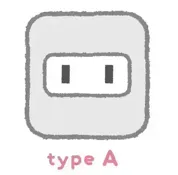
What You Need to Know:
- Shape: Two flat, parallel prongs, similar to the “T” shape.
- Grounding: No grounding pin, so it’s safer for lower-power devices but not ideal for high-power appliances.
- Voltage Compatibility: Japan runs on 100V, which matches the voltage of Type A plugs. No need for a voltage converter if you're using this plug.
- Where You'll See It: This is the most common plug in Japan. You'll find it in hotels, cafes, and homes, especially for low-power devices like phone chargers, laptops, and cameras.
Type B
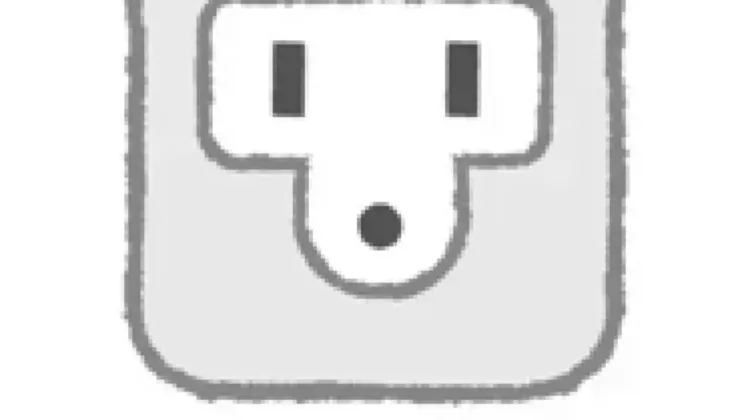
What You Need to Know:
- Shape: Two flat prongs in a parallel shape, plus a third round pin for grounding.
- Grounding: The third pin adds an extra layer of safety, making it ideal for higher-power devices like computers, kitchen appliances, or power tools.
- Voltage Compatibility: Like Type A, Type B plugs are designed for 100V, which works perfectly with Japan’s electrical system.
- Where You'll See It: Type B plugs are less common than Type A, but you might encounter them in newer buildings or with appliances that need grounding for safety.
Do You Need a Plug Adapter When Traveling to Japan?
Before you head to Japan, it’s important to know if you need a plug adapter to charge your devices or power your electronics. Japan has a specific type of power outlet, and understanding how to connect your devices will help avoid any inconvenience during your trip.
1. Plug Type Compatibility
Australia uses Type I plugs (three flat pins), while Japan mainly uses Type A (two flat pins) and Type B (two flat pins plus a round grounding pin). Type I is not commonly found in Japan, so you may need an adapter to use your Australian devices.
2. Voltage and Frequency
- Australia: 230V, 50Hz
- Japan: 100V, 50/60Hz
The voltage difference between Australia (230V) and Japan (100V) is significant. Many Australian devices, such as hairdryers or electric shavers, may not work properly in Japan without a voltage converter in addition to an adapter. However, low-power devices like phones, laptops, and cameras usually work fine, but make sure to check if your device can support 100V.
3. Do You Need an Adapter?
Common Scenarios:
| Device | Adapter Needed? | Notes |
| Phone Charger | Yes (Type I to Type A adapter) | Phone chargers usually work fine with Type A, no voltage issue. |
| Laptop | Yes (Type I to Type A adapter) | Voltage is lower in Japan, so a voltage converter might be needed for some laptops. |
| Hair Dryer / Electric Shaver | Yes (Type I to Type A adapter and Voltage Converter) | High-power devices usually require both an adapter and a voltage converter. Check your device's voltage range. |
| USB Charging Devices | No | USB ports are universal, so no adapter needed. |
Standard Socket in Japan
Traveling to Japan? Before you pack your electronic gadgets, it’s crucial to understand the standard sockets in Japan to ensure your devices stay charged and ready to go!
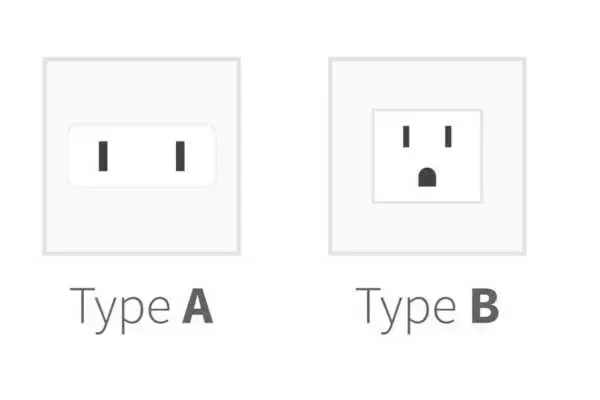
Here’s Why It’s Awesome:
- One Socket Fits Two Plug Types: You won’t need multiple adapters when traveling in Japan—these sockets work with both Type A and Type B plugs, making them super versatile.
- Effortless Plugging In: Whether your device has a basic two-prong plug or a three-prong plug with grounding, these sockets can handle it all. Perfect for everything from phone chargers to laptops.
- Safety First: The Type B portion of the socket includes a grounding pin, providing added safety for higher-powered devices like laptops and hairdryers. This ensures a secure connection and reduces the risk of electrical hazards.
- Widely Available: From hotels and airports to cafes and shopping centers, these sockets are standard across Japan. Travelers will rarely need to search for specialized outlets or worry about their plugs not fitting.
Types of Travel Adapters for Japan
Keeping your devices charged is essential for a smooth journey. Choosing the right travel adapter is key, especially since Japan uses specific plug types. Here’s a breakdown of the different types of adapters to help you pick the best one for your trip:
1. Basic Plug Adapters
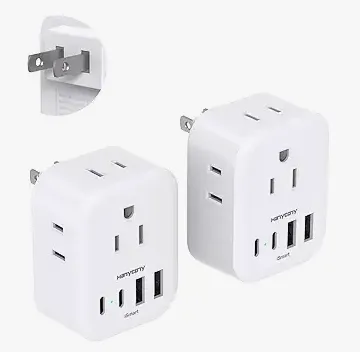
Source from Amazon.com
What it is: A simple and lightweight solution to connect your devices to Japanese outlets.
Japan primarily uses Type A plugs (two flat prongs) and occasionally Type B plugs (two flat prongs with a grounding pin). A basic Japan power plug adapter converts foreign plugs to fit these outlet types. These adapters are ideal for travelers with minimal devices, offering a compact and straightforward solution to keep your gadgets powered. Whether you’re charging a phone or camera, a basic adapter is an affordable and practical option for your Japan trip.
Best for: Short trips with minimal devices, where you only need to connect to Type A or Type B outlets in Japan.
2. Multi-Port Adapters
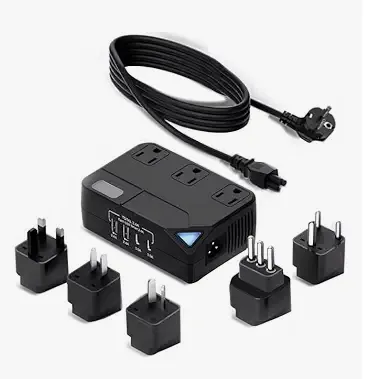
Source from Amazon.com
What it is: A handy adapter for charging multiple devices at once.
If you’re traveling with several gadgets—like a smartphone, tablet, laptop, and power bank—a multi-port Japan power plug adapter can make a world of difference. These adapters often include several sockets and USB ports, allowing you to charge multiple devices simultaneously. This is perfect for families, tech-savvy travelers, or anyone bringing multiple devices to Japan. By reducing the need for multiple chargers, multi-port adapters save space and ensure all your gadgets stay powered throughout your trip.
Best for: Long stays, multiple devices, or group travel in Japan, where you need to charge several gadgets at the same time.
3. Universal Travel Adapters
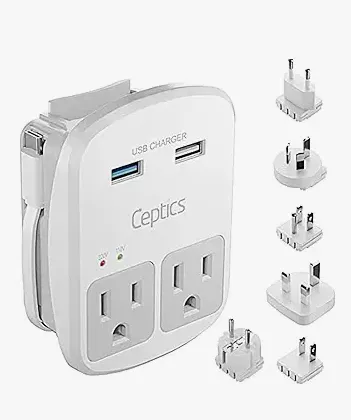
Source from Amazon.com
What it is: A versatile adapter compatible with outlets in multiple countries.
If your trip to Japan is part of a multi-country journey, a universal travel adapter is a smart investment. These adapters include interchangeable plugs that work in various regions, including Japan, North America, Europe, and more. Many universal adapters also support dual voltage (110V/220V), so they’re perfect for devices that require specific voltage settings. Compact and multifunctional, a universal adapter is a convenient choice for frequent travelers who want one solution for multiple destinations.
Best for: Travelers visiting Japan and other countries who need a single adapter that works across different regions.
4. Compact Travel Adapters
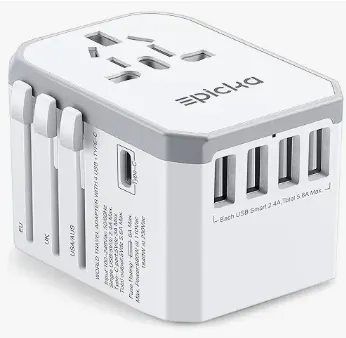
Source from Amazon.com
What it is: A lightweight and portable adapter for minimalist travelers.
Heading to Japan for a short trip with just a few devices? A compact Japan power plug adapter is the perfect solution. Designed for portability, these adapters take up very little space in your luggage. They’re great for travelers with light packing habits who only need to charge essentials like a smartphone, tablet, or camera. Despite their small size, compact adapters are reliable and efficient, making them a must-have for short stays in Japan.
Best for: Travelers on short trips or with minimal device usage who want a lightweight adapter for Japan’s power outlets.
Where to Buy Travel Adapters for Japan

Keeping your devices charged while traveling in Japan is essential, and finding the right travel adapter is a must. Whether you prefer to buy it before your trip or after you arrive, here’s a guide to help you locate the perfect Japan power plug adapter:
1. Before You Leave: Online Shopping
Purchasing an adapter online before your trip is the most convenient option. Here are some popular online stores where you can find a Japan power plug adapter:
| Store | Best For | Pros | Cons |
| Amazon | Wide variety (basic & universal) | Great selection, delivered to your door | Delivery times may vary |
| eBay | Budget-friendly options | Affordable, lots of choices | Risk of buying from unknown sellers |
| AliExpress | Cheap and bulk purchases | Lots of options at low prices | Delivery may take longer |
| Best Buy | Reliable and fast delivery | Trusted brand, easy returns | Limited selection compared to others |
| Gearbest | Compact and travel-sized adapters | Good for small, portable adapters | May need more research for quality |
Pros: You can shop from a variety of options and have the adapter delivered to your home.
Cons: Shipping times vary, especially for international orders, so plan ahead!
2. At the Airport: Quick and Easy
If you’re in a rush, the airport can be a lifesaver for purchasing a travel adapter. Forgot to pack one? No worries—most airports carry adapters suitable for Japanese outlets.
| Store | Best For | Pros | Cons |
| Duty-Free Stores | Basic plug adapters | Convenient, available as you travel | Higher prices |
| Electronics Shops | Universal and multi-port adapters | Decent quality, easy to find | Limited selection, more expensive |
Pros: Perfect for last-minute purchases.
Cons: Expect to pay premium prices for convenience.
3. Once You Arrive: Local Shops in Japan
If you didn’t manage to buy an adapter before your trip or need a spare, Japan offers plenty of local options for purchasing travel adapters in its major cities.
| Store | Best For | Pros | Cons |
| Electronics Stores (Bic Camera, Yodobashi) | Variety of plug and universal adapters | High-quality selection | Can be pricier than online stores |
| Supermarkets (Aeon, Ito-Yokado) | Basic plug adapters (Type A, B) | Convenient, found in major cities | Limited selection of advanced adapters |
| Tech Stores (Apple, Sony) | Chargers and high-quality adapters | Great for tech gadgets and accessories | Higher-end options, often expensive |
| Online (Rakuten, Amazon Japan) | Anything from basic to multi-port | Wide variety, fast delivery in cities | Delivery may take longer in remote areas |
Pros: Easy to find in big cities like Tokyo or Osaka.
Cons: May be pricier than shopping online ahead of time.
4. Convenience Stores & Hotels: For Quick Access
If you’re in a pinch, convenience stores or your hotel can often provide a solution for your adapter needs.
| Store | Best For | Pros | Cons |
| Convenience Stores (7-Eleven, Lawson) | Basic adapters | Convenient, widely available | Limited choices, slightly overpriced |
| Hotels | Last-minute adapters | Easy access, especially in premium hotels | Prices can be very high |
Pros: Ideal for urgent situations.
Cons: Limited options and high prices.
Stay Connected in Japan with an eSIM
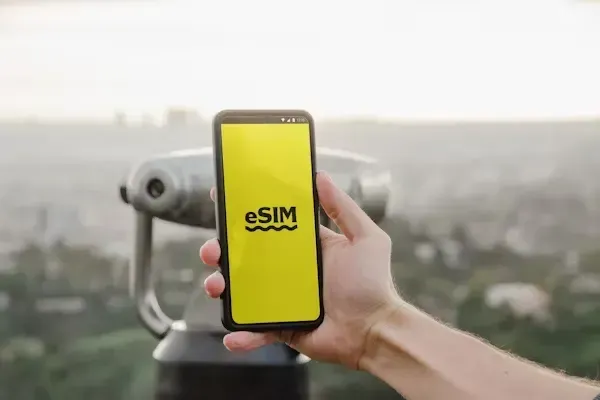
What is an eSIM?
An eSIM (embedded SIM) is a digital SIM card built into your device, allowing you to activate a cellular plan without needing a physical card. It offers easy connectivity, flexibility to switch carriers, and eliminates the risk of losing a SIM card.
Benefits for Travelers in Japan
- Instant Connectivity: Activate your plan as soon as you arrive in Japan.
- No Physical SIM Required: Avoid swapping SIM cards or losing them.
- Multiple Plans: Manage multiple data plans on one device.
Trip.com eSIM for Japan
Trip.com provides an easy-to-activate eSIM for Japan, offering reliable data coverage across the country. It’s perfect for short-term travelers, offering flexibility and convenience without the need for physical SIM cards.
- CountryJapan
- Package Option500MB/Day
- Number of Days1 Day
- PriceAU $1.00
- CountryJapan
- Package Option1GB/Day
- Number of Days5 Days
- PriceAU $4.77
- CountryJapan
- Package Option10GB
- Number of Days15 Days
- PriceAU $11.56
Booking Your Trip to Japan
1. Flight Recommendations
Tips for Booking Affordable Flights to Japan
- Be Flexible with Dates: Flight prices to Japan can vary widely based on the season and day of the week. Use flexible date search features to find the best deals.
- Set Price Alerts: Use flight comparison websites to set up price alerts for flights to Japan. This will help you monitor price changes and secure the best rates.
- Book in Advance: For the best prices, book your flight to Japan several months ahead, especially during peak travel seasons such as cherry blossom time (spring) or the holiday season (December).
Highlight Special Deals Available on Trip.com
Trip.com often features exclusive discounts for flights to Japan. Be sure to check their promotions page for limited-time offers and special deals. Here’s a snapshot of some of their best options:
- One way
- Return
- direct cheapest
 SYD09:159h 40mDirectHND16:55Sydney - Tokyo|Tue, Jan 27|Japan AirlinesSEK 6,222SEK 7,68219% off19% offSEK 7,682SEK 6,222
SYD09:159h 40mDirectHND16:55Sydney - Tokyo|Tue, Jan 27|Japan AirlinesSEK 6,222SEK 7,68219% off19% offSEK 7,682SEK 6,222  SYD09:159h 40mDirectHND16:55Sydney - Tokyo|Tue, Feb 17|Japan AirlinesSEK 6,683SEK 7,68213% off13% offSEK 7,682SEK 6,683
SYD09:159h 40mDirectHND16:55Sydney - Tokyo|Tue, Feb 17|Japan AirlinesSEK 6,683SEK 7,68213% off13% offSEK 7,682SEK 6,683 SYD21:5026h 50m1 stopHND22:40Sydney - Tokyo|Tue, Mar 3|AirAsia XSEK 1,510SEK 7,68280% off80% offSEK 7,682SEK 1,510
SYD21:5026h 50m1 stopHND22:40Sydney - Tokyo|Tue, Mar 3|AirAsia XSEK 1,510SEK 7,68280% off80% offSEK 7,682SEK 1,510 SYD1:00 PM3h 5mDirectTYO2:00 PMSydney - Tokyo|Sat, Dec 27|Japan AirlinesFind more flightsFind more flights
SYD1:00 PM3h 5mDirectTYO2:00 PMSydney - Tokyo|Sat, Dec 27|Japan AirlinesFind more flightsFind more flights
Displayed flight fares from ${{departCityName}} to ${{arrivalCityName}} are based on average prices across airlines for the next 3 months, according to the latest Trip.com database.
2. Hotel Recommendations in Japan
Explore the Best Hotels in Japan’s Top Cities! Whether you're looking for luxury, comfort, or a budget-friendly stay, Japan offers a wide range of accommodations to suit every type of traveler. From Tokyo’s bustling metropolis to Kyoto’s serene temples, here’s where to stay in Japan’s must-visit cities:
Tokyo
Best Hotels in Tokyo
5 star
Business travel
Family friendly
Hot spring
Osaka
Best Hotels in Osaka
5 star
Business travel
Family friendly
Hot spring
FAQs about Japan Power Plug
What type of power plugs are used in Japan?
Japan primarily uses Type A and Type B power plugs: Type A: Two flat parallel pins (unpolarized). Type B: Two flat parallel pins and a round grounding pin.What is the voltage in Japan?
Japan operates on a 100V voltage with a frequency of either 50 Hz (in Eastern Japan, including Tokyo) or 60 Hz (in Western Japan, including Osaka and Kyoto).Do I need a plug adapter for Japan?
Yes, if your devices have a different plug type (such as Type I or Type G used in countries like Australia, the UK, or the US), you will need a plug adapter to fit into the Japanese sockets.Will my electrical devices work in Japan?
If your device supports dual voltage (100V-240V), it will work in Japan with just a plug adapter. Check your device's voltage rating (usually found on the charger or power brick). If your device only supports 110V (common in countries like the US), it may still work in Japan since Japan uses 100V. However, voltage differences might cause issues with certain appliances or devices. A voltage converter may be required if your device isn't rated for 100V.What is the frequency in Japan?
Japan uses two different frequencies, depending on the region: 50 Hz in Eastern Japan (including Tokyo). 60 Hz in Western Japan (including Osaka, Kyoto). If your device is sensitive to frequency (such as clocks or some motors), check if it can handle both 50 Hz and 60 Hz frequencies.Are there any specific safety concerns when using electrical appliances in Japan?
Japan's electrical system is generally safe, but it’s important to use the correct adapter and verify the voltage of your device to avoid potential damage. For devices that require grounding (like larger electronics), you should use a Type B plug with a grounding pin.Can I find plug adapters easily in Japan?
Yes, plug adapters are widely available in electronics stores, convenience stores, tourist shops, and airports in major cities like Tokyo, Osaka, and Kyoto. They are also sold in department stores.What should I do if I forget to bring a plug adapter?
If you forget to bring a plug adapter, you can easily find one in electronics shops, airport duty-free stores, or department stores throughout Japan.Can I charge my phone or laptop in Japan?
Yes, you can charge your phone, laptop, or other electronic devices in Japan as long as you have the correct plug adapter. Be sure to check whether your device supports 100V. Most modern electronics like smartphones and laptops are dual voltage and can handle the 100V input without issues.

